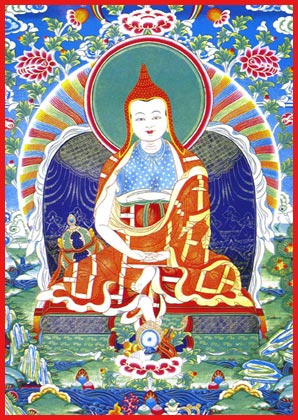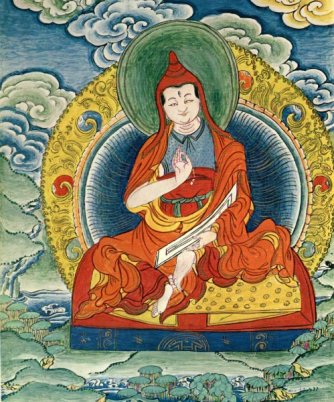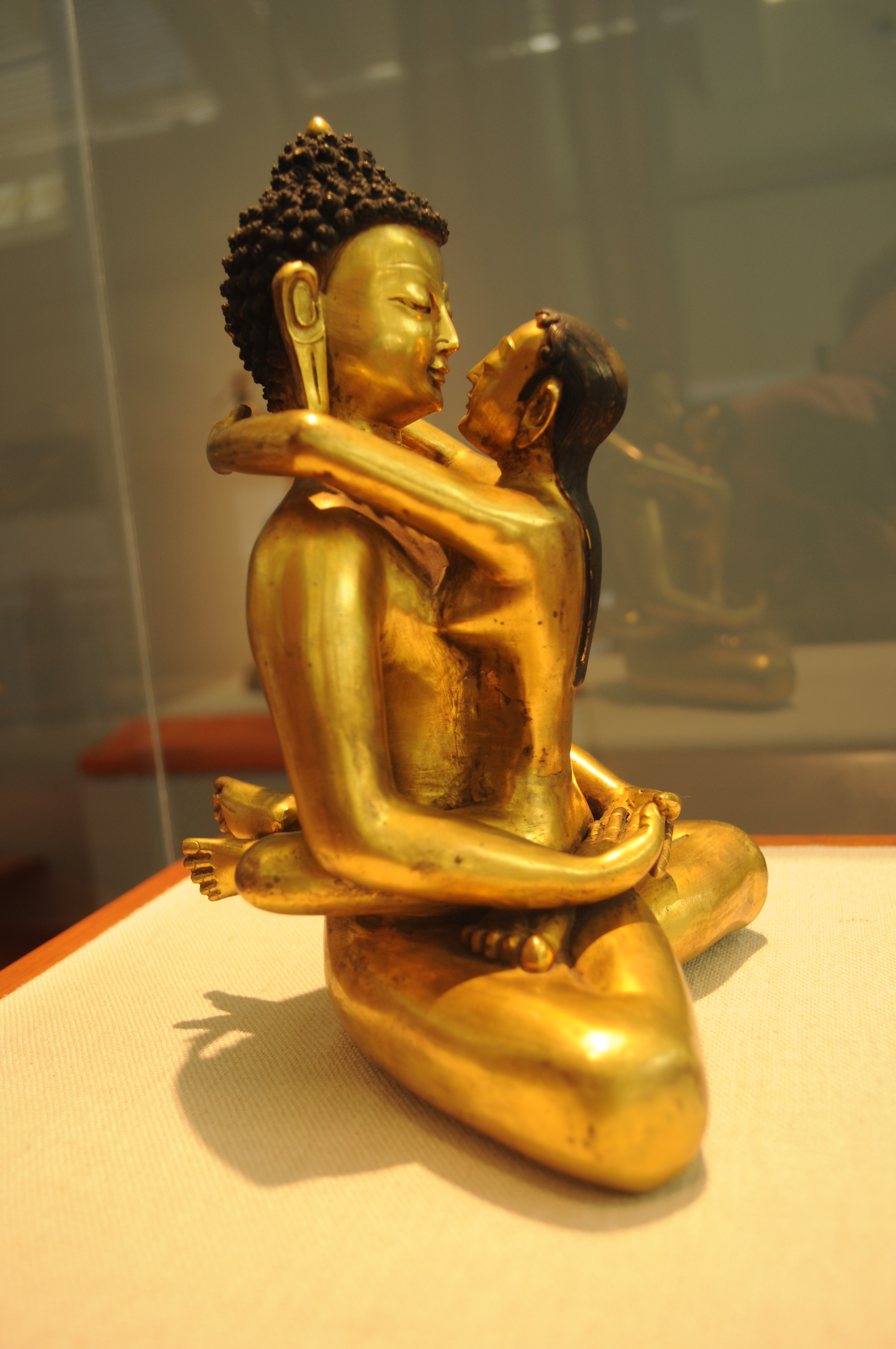|
Mañjuśrīmitra
Mañjuśrīmitra (d. 740 CE) () was an Indian Buddhism, Buddhist scholar. He became the main student of Garab Dorje and a teacher of Dzogchen. Nomenclature and etymology Mañjuśrī-mitra was his ordination-name—before ordination he was named "Siddhi-garbha" and "Samvara-garbha" His mother's name was Kuhanā. Birth and early life The exact location of Mañjuśrīmitra's birth is unknown. Mañjuśrīmitra, the son of an upper class Brahmin from a village to the west of Bodh Gaya, was initially schooled at home. Later he was a resident at Nalanda University where he became a respected Yogachara, Yogācāra scholar and practitioner. Works Many of Mañjuśrīmitra's works deal with a Tantra, tantric text Mañjuśrīnāmasamgīti. He was the person who divided the Dzogchen teachings into three series of Semde, Longdé and Manngagde. In the Tibetan Buddhist Vajrayana tradition, Mañjuśrīmitra is held to have transmitted the Dzogchen teachings to Sri Singha. The "Six Meditation Exp ... [...More Info...] [...Related Items...] OR: [Wikipedia] [Google] [Baidu] |
Semde
Semde (; Sanskrit: , "mind division", "mind class" or "mind series" is the name of one of three scriptural and lineage (Buddhism), lineage divisions within the Dzogchen (Great Perfection) tradition. The Nyingma school of Tibetan Buddhism traditionally classifies its Dzogchen teaching into three main divisions: Semde, Longdé (Space Series) and Menngagde (Secret Instruction Series). Semde texts are mostly said to be translations by figures of History of Tibetan Buddhism#First dissemination (7th–9th centuries), the early transmission (7th–9th centuries) of Buddhism to Tibet like Sri Singha, Śrī Siṅgha, Vairotsana and Vimalamitra. These texts emphasize the "awakened mind" (Tibetan: ''byang-chub-kyi sems'', Skt. ''bodhicitta''), which is the true nature of the mind and is essentially pure and perfect, just like Buddhahood. Semde texts critique tantric practice as being based on effort, and instead promote simple and effortless contemplation of the mind and its Emptiness (Buddhi ... [...More Info...] [...Related Items...] OR: [Wikipedia] [Google] [Baidu] |
Manngagde
In Tibetan Buddhism and Bon, Menngagde (, ), is the name of one of three scriptural and lineage divisions within Dzogchen (''Great Perfection'' ). Dzogchen is itself the pinnacle of the ninefold division of practice according to the Nyingma school of Tibetan Buddhism. Menngagde focuses on rigpa. The Menngagde or 'Instruction Class' of Dzogchen teachings are divided into two parts: ''trekchö'' and ''tögel''. Practice For general purposes, Menngagde may also be known as Nyingthik. Germano & Gyatso (2000: p. 240) note a similarity of practice between Chan-like formless meditations and Nyingthik/Menngagde: In the Dzogchen textual tradition Traditionally, Mañjuśrīmitra () is said to have classified all the Dzogchen teachings transmitted by his teacher, Garab Dorje, into three series: semdé (), Longdé (), and menngagdé. Mañjuśrīmitra's student Sri Singha reedited the oral instruction cycle and in this form the teaching was transmitted to Jñānasūtra and ... [...More Info...] [...Related Items...] OR: [Wikipedia] [Google] [Baidu] |
Ati Yoga
Dzogchen ( 'Great Completion' or 'Great Perfection'), also known as ''atiyoga'' ( utmost yoga), is a tradition of teachings in Indo-Tibetan Buddhism and Bön aimed at discovering and continuing in the ultimate ground of existence. The goal of Dzogchen is the direct experience of this basis, called (Sanskrit: ). There are spiritual practices taught in various Dzogchen systems for discovering . Dzogchen emerged during the first dissemination of Buddhism in Tibet, around the 7th to 9th centuries CE. While it is considered a Tibetan development by some scholars, it draws upon key ideas from Indian sources. The earliest Dzogchen texts appeared in the 9th century, attributed to Indian masters. These texts, known as the Eighteen Great Scriptures, form the "Mind Series" and are attributed to figures like Śrī Siṅgha and Vimalamitra. Early Dzogchen was marked by a departure from normative Vajrayāna practices, focusing instead on simple calming contemplations leading to a di ... [...More Info...] [...Related Items...] OR: [Wikipedia] [Google] [Baidu] |
Garab Dorje
Garab Dorje (c. 665) () was the first human to receive the complete direct transmission teachings of Sutra, Tantra and Dzogchen. The circumstances of his birth are shrouded in different interpretations, with some accounts describing a miraculous birth by a virgin daughter of the king of Uddiyana. Garab Dorje became the first teacher of Dzogchen ("Great Perfection", also called ''Ati Yoga'') teachings. Garab Dorje's core teachings revolve around understanding the nature of the mind as the original Buddha, beyond birth and cessation, emphasizing meditation as a practice of allowing this natural state without seeking, this is the highest teaching in Buddhism. According to the Nyingma school tradition of Tibetan Buddhism Tibetan Buddhism is a form of Buddhism practiced in Tibet, Bhutan and Mongolia. It also has a sizable number of adherents in the areas surrounding the Himalayas, including the Indian regions of Ladakh, Gorkhaland Territorial Administration, D ..., he transmit ... [...More Info...] [...Related Items...] OR: [Wikipedia] [Google] [Baidu] |
Dzogchen
Dzogchen ( 'Great Completion' or 'Great Perfection'), also known as ''atiyoga'' ( utmost yoga), is a tradition of teachings in Indo-Tibetan Buddhism and Bön aimed at discovering and continuing in the ultimate ground of existence. The goal of Dzogchen is the direct experience of this basis, called (Sanskrit: ). There are spiritual practices taught in various Dzogchen systems for discovering . Dzogchen emerged during the first dissemination of Buddhism in Tibet, around the 7th to 9th centuries CE. While it is considered a Tibetan development by some scholars, it draws upon key ideas from Indian sources. The earliest Dzogchen texts appeared in the 9th century, attributed to Indian masters. These texts, known as the Eighteen Great Scriptures, form the "Mind Series" and are attributed to figures like Śrī Siṅgha and Vimalamitra. Early Dzogchen was marked by a departure from normative Vajrayāna practices, focusing instead on simple calming contemplations leading to a di ... [...More Info...] [...Related Items...] OR: [Wikipedia] [Google] [Baidu] |
Sri Singha
Sri Singha (Sanskrit: , ) was the teacher of Padmasambhava, Vimalamitra, and Vairotsana. He was a principal student and dharma-son of Mañjuśrīmitra in the Dzogchen lineage, and is credited by the Nyingma school with introducing Dzogchen to Tibet. Life Sri Singha is the son of King 'Accomplisher' and his wife queen Nantakā. A.W. Barber notes that Sri Simha took the Atiyoga lineage to Andhra, in South India. He made his residence at Dhanyakataka. Thus, it would appear that Sri Simha took the Atiyoga line to Andhra and made his residence at the famous Dhanyakataka along the Krishna River. From here it was transmitted to teachers who then took the line to Tibet and China. Achievements Śrī Siṃha brought the Secret Mantra teachings from beneath the Vajra Throne in Bodhgaya to the 'Tree of Enlightenment' in China, where he concealed them in a pillar of the 'Auspicious Ten Thousand Gates Temple'. Śrī Siṃha conferred the Eighteen Dzogchen Tantras (Tibetan: ''rdzogs ... [...More Info...] [...Related Items...] OR: [Wikipedia] [Google] [Baidu] |
Dzogchen Lamas
Dzogchen ( 'Great Completion' or 'Great Perfection'), also known as ''atiyoga'' ( utmost yoga), is a tradition of teachings in Indo-Tibetan Buddhism and Bön aimed at discovering and continuing in the ultimate ground of existence. The goal of Dzogchen is the direct experience of this basis, called (Sanskrit: ). There are spiritual practices taught in various Dzogchen systems for discovering . Dzogchen emerged during the first dissemination of Buddhism in Tibet, around the 7th to 9th centuries CE. While it is considered a Tibetan development by some scholars, it draws upon key ideas from Indian sources. The earliest Dzogchen texts appeared in the 9th century, attributed to Indian masters. These texts, known as the Eighteen Great Scriptures, form the "Mind Series" and are attributed to figures like Śrī Siṅgha and Vimalamitra. Early Dzogchen was marked by a departure from normative Vajrayāna practices, focusing instead on simple calming contemplations leading to a di ... [...More Info...] [...Related Items...] OR: [Wikipedia] [Google] [Baidu] |
Chittamatra
Yogachara (, IAST: ') is an influential tradition of Buddhist philosophy and psychology emphasizing the study of cognition, perception, and consciousness through the interior lens of meditation, as well as philosophical reasoning (hetuvidyā). Yogachara was one of the two most influential traditions of Mahayana Buddhism in India, along with Madhyamaka. The compound ''Yogācāra'' literally means "practice of yoga", or "one whose practice is yoga", hence the name of the school is literally "the school of the yogins". Yogācāra was also variously termed ''Vijñānavāda'' (the doctrine of consciousness), ''Vijñaptivāda'' (the doctrine of ideas or percepts) or ''Vijñaptimātratā-vāda'' (the doctrine of 'mere representation'), which is also the name given to its major theory of mind which seeks to deconstruct how we perceive the world. There are several interpretations of this main theory: various forms of Idealism, as well as a phenomenology or representationalism. A ... [...More Info...] [...Related Items...] OR: [Wikipedia] [Google] [Baidu] |
Philosophy
Philosophy ('love of wisdom' in Ancient Greek) is a systematic study of general and fundamental questions concerning topics like existence, reason, knowledge, Value (ethics and social sciences), value, mind, and language. It is a rational and critical inquiry that reflects on its methods and assumptions. Historically, many of the individual sciences, such as physics and psychology, formed part of philosophy. However, they are considered separate academic disciplines in the modern sense of the term. Influential traditions in the history of philosophy include Western philosophy, Western, Islamic philosophy, Arabic–Persian, Indian philosophy, Indian, and Chinese philosophy. Western philosophy originated in Ancient Greece and covers a wide area of philosophical subfields. A central topic in Arabic–Persian philosophy is the relation between reason and revelation. Indian philosophy combines the Spirituality, spiritual problem of how to reach Enlightenment in Buddhism, enlighten ... [...More Info...] [...Related Items...] OR: [Wikipedia] [Google] [Baidu] |
Logic
Logic is the study of correct reasoning. It includes both formal and informal logic. Formal logic is the study of deductively valid inferences or logical truths. It examines how conclusions follow from premises based on the structure of arguments alone, independent of their topic and content. Informal logic is associated with informal fallacies, critical thinking, and argumentation theory. Informal logic examines arguments expressed in natural language whereas formal logic uses formal language. When used as a countable noun, the term "a logic" refers to a specific logical formal system that articulates a proof system. Logic plays a central role in many fields, such as philosophy, mathematics, computer science, and linguistics. Logic studies arguments, which consist of a set of premises that leads to a conclusion. An example is the argument from the premises "it's Sunday" and "if it's Sunday then I don't have to work" leading to the conclusion "I don't have to wor ... [...More Info...] [...Related Items...] OR: [Wikipedia] [Google] [Baidu] |
Three Turnings Of The Wheel Of Dharma
Buddhist Doctrinal Classification refers to various systems used by Mahayana, Mahāyāna Buddhist traditions to classify and organize the numerous texts and teachings that have developed over the history of Buddhism. According to Buddhist studies, buddhologist Peter Gregory, these classification systems fulfill three interwoven roles for Buddhist traditions: Hermeneutics, hermeneutical, Sectarianism, sectarian, and Soteriology, soteriological. From an hermeneutical standpoint, they function as a method of organizing Buddhist texts both chronologically and hierarchically, thereby producing a doctrinal structure that is internally coherent and logically consistent. In its sectarian application, different Buddhist schools evaluate and order scriptures based on their own doctrinal priorities, using this to legitimize their specific traditions. From a soteriological perspective, classification schemas map out a graded path of spiritual development, wherein the practitioner’s insight e ... [...More Info...] [...Related Items...] OR: [Wikipedia] [Google] [Baidu] |









